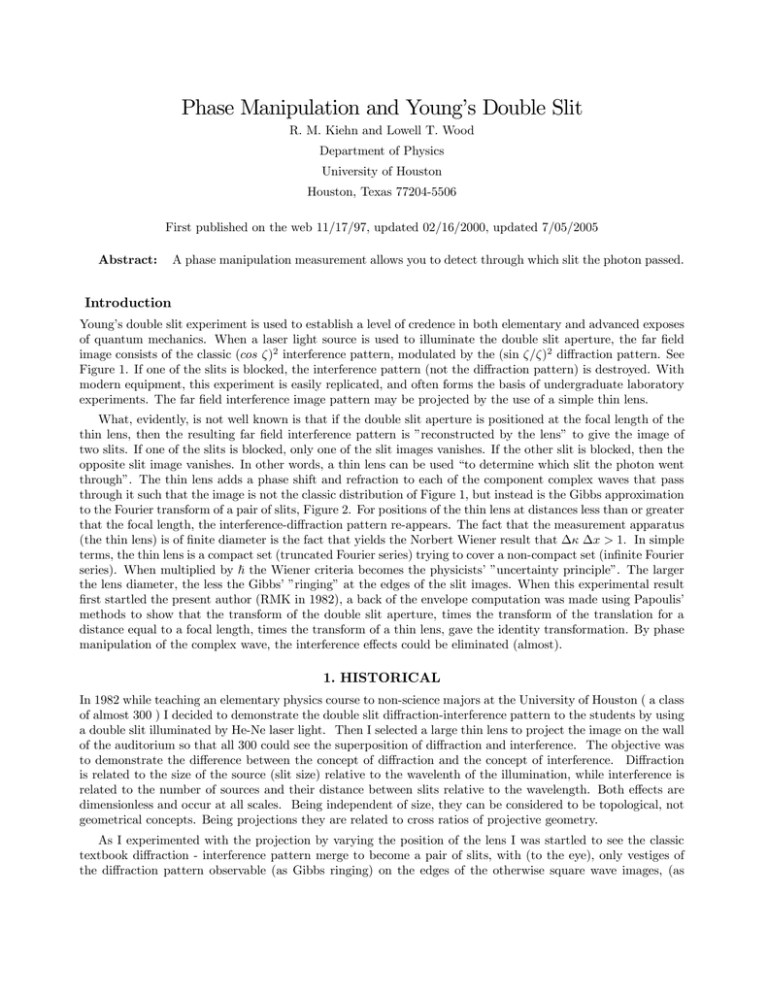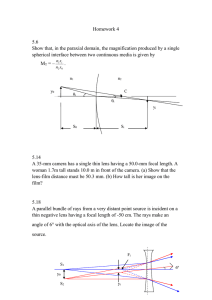Phase Manipulation and Young`s Double Slit
advertisement

Phase Manipulation and Young’s Double Slit R. M. Kiehn and Lowell T. Wood Department of Physics University of Houston Houston, Texas 77204-5506 First published on the web 11/17/97, updated 02/16/2000, updated 7/05/2005 Abstract: A phase manipulation measurement allows you to detect through which slit the photon passed. Introduction Young’s double slit experiment is used to establish a level of credence in both elementary and advanced exposes of quantum mechanics. When a laser light source is used to illuminate the double slit aperture, the far field image consists of the classic (cos ζ)2 interference pattern, modulated by the (sin ζ/ζ)2 diffraction pattern. See Figure 1. If one of the slits is blocked, the interference pattern (not the diffraction pattern) is destroyed. With modern equipment, this experiment is easily replicated, and often forms the basis of undergraduate laboratory experiments. The far field interference image pattern may be projected by the use of a simple thin lens. What, evidently, is not well known is that if the double slit aperture is positioned at the focal length of the thin lens, then the resulting far field interference pattern is ”reconstructed by the lens” to give the image of two slits. If one of the slits is blocked, only one of the slit images vanishes. If the other slit is blocked, then the opposite slit image vanishes. In other words, a thin lens can be used “to determine which slit the photon went through”. The thin lens adds a phase shift and refraction to each of the component complex waves that pass through it such that the image is not the classic distribution of Figure 1, but instead is the Gibbs approximation to the Fourier transform of a pair of slits, Figure 2. For positions of the thin lens at distances less than or greater that the focal length, the interference-diffraction pattern re-appears. The fact that the measurement apparatus (the thin lens) is of finite diameter is the fact that yields the Norbert Wiener result that ∆κ ∆x > 1. In simple terms, the thin lens is a compact set (truncated Fourier series) trying to cover a non-compact set (infinite Fourier series). When multiplied by } the Wiener criteria becomes the physicists’ ”uncertainty principle”. The larger the lens diameter, the less the Gibbs’ ”ringing” at the edges of the slit images. When this experimental result first startled the present author (RMK in 1982), a back of the envelope computation was made using Papoulis’ methods to show that the transform of the double slit aperture, times the transform of the translation for a distance equal to a focal length, times the transform of a thin lens, gave the identity transformation. By phase manipulation of the complex wave, the interference effects could be eliminated (almost). 1. HISTORICAL In 1982 while teaching an elementary physics course to non-science majors at the University of Houston ( a class of almost 300 ) I decided to demonstrate the double slit diffraction-interference pattern to the students by using a double slit illuminated by He-Ne laser light. Then I selected a large thin lens to project the image on the wall of the auditorium so that all 300 could see the superposition of diffraction and interference. The objective was to demonstrate the difference between the concept of diffraction and the concept of interference. Diffraction is related to the size of the source (slit size) relative to the wavelenth of the illumination, while interference is related to the number of sources and their distance between slits relative to the wavelength. Both effects are dimensionless and occur at all scales. Being independent of size, they can be considered to be topological, not geometrical concepts. Being projections they are related to cross ratios of projective geometry. As I experimented with the projection by varying the position of the lens I was startled to see the classic textbook diffraction - interference pattern merge to become a pair of slits, with (to the eye), only vestiges of the diffraction pattern observable (as Gibbs ringing) on the edges of the otherwise square wave images, (as the position of the lens relative to the two slits was varied). The effect occured when the double slit was at a distance from the lens equal to the focal length of the lens. After pondering this observable result, I read sections of Papoulis’ book on "Systems and Transforms with Applications in Optics" McGraw Hill 1968 and then was led to conclusion that the product of the transforms of a double slit with plane wave illumination, times a translation by a distance d, times a thin lens yielded the identity transform when the distance d was a focal length of the thin lens. As I remember, if you block transmission through one of the two slits, one of the projected "image lines" disappears. If the block the other slit, then the other "image line" disappears. I had been trained at MIT and through private reading to believe the Dogma that the double slit experiment justified the Copenhagen probalistic view of both quantum theory, and that the Heisenberg "uncertainty" principle, both topics being presumed applicable to the realm of microscopic quantum theory. When QM states that a measurement must be a real number, the anti-symmetries of the complex wave field (the phases) are to be thrown away! What a stupid disaster! Certainly not valid in the theory of holograms. (I had also been taught that you can measure amplitudes but you could not control or measure phase). However, a lens is precisely a method for controling the phase along a path. I now know that the double slit diffraction and interference occur at all scales as does the Heisenberg uncertainty priniciple. These concepts are topological concepts, not geometrical concepts, and do not depend upon geometric scales. For example, when the double slit is at the focal length, the displayed images are not precisely square pulses, but have a Fourier-Gibbs ringing on the edges making the width of the image not that of a perfect square pulse. As the size of the lens is increased, the Gibbs ringing is decreased, but it never reduced to zero unless the sized of the lens is infinite. Some of the wave energy emanating from the slit is not captured by the lens of finite diameter. The Heisenberg Uncertainty principle is not a non-classical mystery, for from a topological point of view it is equivalent to the statement that you cannot cover an infinite set with a finite set. The same conclusion was obtained in the 1920,s lecture of Norbert Wiener where he showed that a truncated (instead of and infinite) Fourier Series always gave an error such that ∆k∆x ≥ 1. It does not take a rocket scientist to multiply this result by Planck’s constant and use the deBroglie relations to get the "Heisenberg formula": ∆p∆x ≥ 1. I am told that Heisenberg attend Wiener’s lecture on Fourier theory in Germany, and that Wiener was highly upset that Heisenberg never gave credit to Wiener. For years, I put the project aside, as I thought it would serve as an excellent project for a graduate thesis. I liked to have a set of thesis topics to offer to incoming graduate students. However, at the time most graduate students were interested in advancing their careers and finding high paying jobs in industry ( solid state ) rather that in a thesis that would buck the main stream of dogma presented in the holy realm of quantum mechanics. As I prepared to retire, a professor at the U of Houston, Lowell Wood, started up and Optics Lab, and I more or less turned the project over to him. 2. EXPERIMENTAL RESULTS Using equipment involving arrays of tiny photocell detectors that ”digitize” the illumination, early experimental results are demonstrated in Figures 2, 3, and 4. (The experiments were conducted by Professor Lowell Wood at the University of Houston a number of years ago, and I expect that they have been improved over the years.) In these three cases, the thin lens is placed at a distance shorter than the focal length, at the focal length, and beyond the focal length of the ”thin” lens. Figures 2 and 4 demonstrates a combined interference-diffraction pattern, while Figure 3 demonstrates the recombined double slit image obtained by positioning the double slit aperture at the focal length. 3. SOME COMPUTATIONAL RESULTS A Maple symbolic math program was written to compute the actual phase shifts generated by rays emanating from a pair of slits, refracting at both the front and rear surfaces of a thin lens, and then recombining on a distant screen. When the lens was positioned at distances not equal to the focal length of the lens, the phase angle defect distribution for rays that traversed the lens form a non-linear distribution about the optical axis of symmetry, a non-linearity which leads to the classic interference patterns for the composition of two rays. However, when the lens was positioned at a distance from the slits equal to the focal length of the lens, the phase angle defect distribution was a linear function about the optic axis of symmetry, and the interference composition vanishes. Similar effects occur for the diffracted compositions. However not all rays traverse through the finite lens, hence the reconstruction is not perfect. 4. REPRISE The fact that optical waves can have both their phase and amplitudes manipulated in experiments should give pause to those who insist on the Copenhagen interpretation of quantum mechanics, an interpretation that presumes that measurable must be expressed by real numbers, and then only in the sense of a probability distribution. The optical Young double slit experiment indeed gives justification for the Wiener - and perhaps the Heisenberg - uncertainty principle, but it does not justify the probability interpretation of quantum mechanics, especially if phase of the quantum wave can be manipulated. Note that the Bohm-Aharanov experiments for electrons indicates that phase effects in quantum mechanics indeed can be manipulated. 5. FIGURE CAPTIONS Figure 1. classic diffraction - interference pattern Figure 2. Digitized data for L < focal length Intensityvs. Distance-0.9f 11.8 10.2 8.6 Potential (V) 7 5.4 3.8 2.2 0.6 -3 -2 -1 0 -1 Distance(mm) 1 2 3 Figure 3. Digitized data for L = focal Length Intensityvs. Distance-1f 11.8 10.2 8.6 Potential (V) 7 5.4 3.8 2.2 0.6 -2 -1 0 -1 Distance(mm) 1 2 Figure 3. Digitized data for L = focal Length OBJECT AT 1.1F 14.0 NORMALIZED IRRADIANCE 12.0 10.0 8.0 6.0 4.0 2.0 0.0 -2.5 -1.5 -0.5 0.5 POSITION (mm) 1.5 2.5




